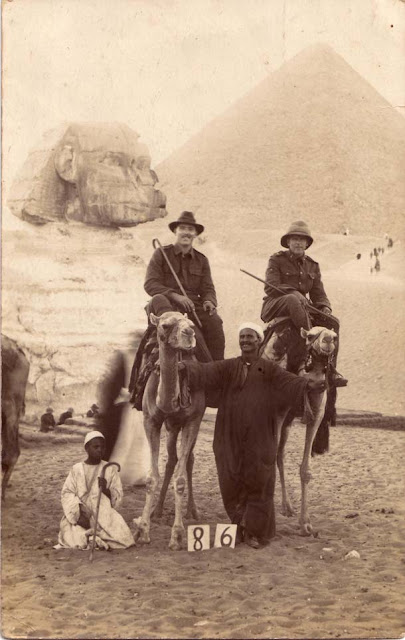The envelope that holds a set of eight postcards belonging to series 20 entitled "Anzacs in France".
The first of the Daily Mail Official War Picture postcards were released for sale in September 1916. There were 80 cards made up of ten series of eight postcards. Many of the images were taken from the Somme battlefields. The full collection of these Daily Mail postcards made a total of 176 cards. Many of the buyers were soldiers' families eager to search through the numerous images of troops at war in the hope they might see their loved ones pictured on the cards.
In January 1917, new Daily Mail postcard series 19 (Australians) and 20 (New Zealanders) were released on to the market. Both series were entitled "Anzacs in France" and the popular "New Zealanders" set of eight postcards can be seen below.
The first postcard of series 20, numbered 153 and entitled "Off to the trenches".
153. ANZACs in France. Off to the trenches
"A battalion of New Zealanders in full kit, and with handcarts, going out to take their spell of duty in the trenches."
The second postcard of series 20, numbered 154 and entitled "New Zealanders loading ammunition".
154. ANZACs in France. New Zealanders loading ammunition.
"These New Zealand artillerymen are packing shells into their limbers from a large open-air dump for the firing line."
The third postcard of series 20, numbered 155 and entitled "New Zealanders cheer the King".
155. ANZACs in France. New Zealanders cheer the King.
"A happy incident during the King's visit. New Zealanders line up along the road-side to cheer King George as he passes." King George V and his entourage are seen here visiting New Zealand troops before they are about to entrain at Steenwerck. The white moustachioed General Herbert Plumer can be seen marching behind the King, General Godley holding his cane is on King George's right shoulder whilst General George Harper is on the King's left shoulder. The visit was photographed in August 1916.
The fourth postcard of series 20, numbered 156 and entitled "Bringing up a gun".
156. ANZACs in France. Bringing up a gun.
"A party of Anzac gunners taking a big gun along a chalk road from which they raise clouds of dust."
Ten strong hard working shire horses are being used to haul this heavy 5 inch gun to its firing position.
The fifth postcard of series 20, numbered 157 and entitled "Bread and Jam".
157. ANZACs in France. Bread and jam
"A party of New Zealanders who have been at work consolidating a trench and are now enjoying a rest with bread and jam". They are men of the 2nd Auckland Infantry Battalion in a trench near the town of Flers in France in 1916.
The sixth postcard of series 20, numbered 158 and entitled "A Brawny Maori Butcher".
158. ANZACs in France. A brawny Maori butcher.
"This Maori soldier of the King is allotted the duties of a butcher, and is seen separating joints of beef with a hatchet".
The seventh postcard of series 20, numbered 159 and entitled "New Zealand Premier's visit".
159. ANZACs in France. New Zealand Premier's visit.
"The Rt Hon. W. F. Massey and Sir Joseph Ward at the Front. They are seen beside a war-plane talking about its capabilities."
The eighth and final card of series 20, numbered 160 and entitled "A queue to the field canteen".
160. ANZACs in France. A queue to the field canteen.
"New Zealanders released from duty. Being all hungry, they adopt the queue plan to avoid a scramble at the canteen".

















